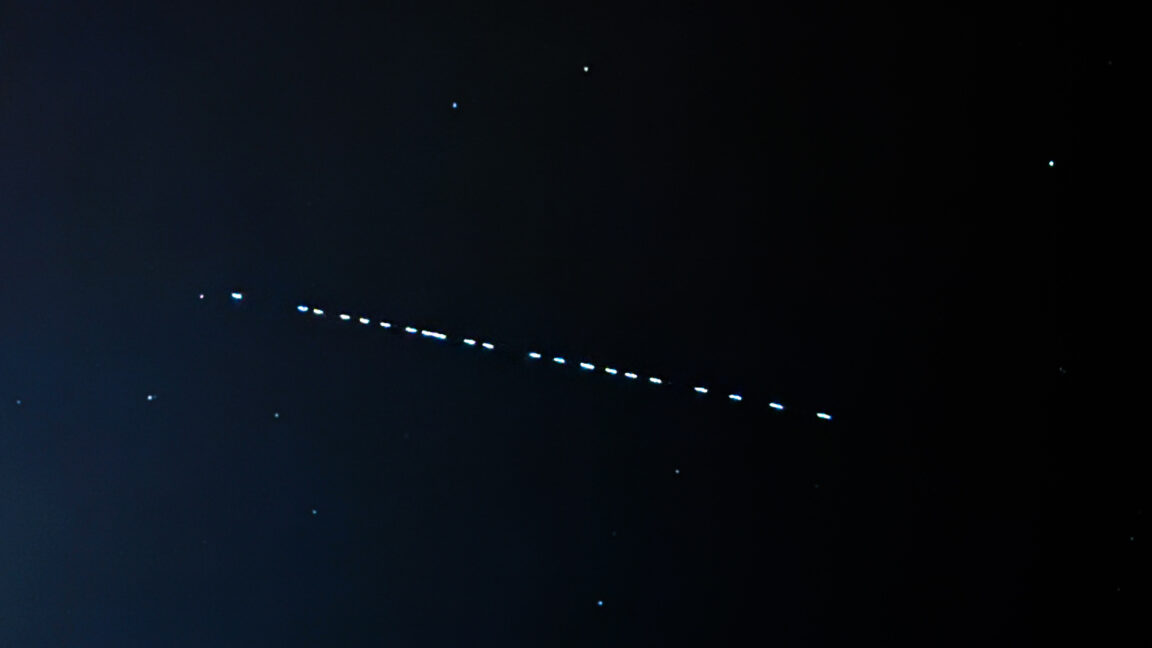
ARSTECHNICA.COM
A lot of people are mistaking Elon Musks Starlink satellites for UAPs
What's that? A lot of people are mistaking Elon Musks Starlink satellites for UAPs "We were able to assess that they were all in those cases looking at Starlink flares." Stephen Clark Nov 15, 2024 3:24 pm | 35 Starlink satellites' passage is seen in the sky in southern Poland on November 1, 2024. Credit: Jakub Porzycki/NurPhoto Starlink satellites' passage is seen in the sky in southern Poland on November 1, 2024. Credit: Jakub Porzycki/NurPhoto Story textSizeSmallStandardLargeWidth *StandardWideLinksStandardOrange* Subscribers only Learn moreSpaceX's Starlink Internet satellites are responsible for more and more public reports of unexplained anomalous phenomena (UAPs), but most recent cases remain unsolved, according to a US government report released Thursday.Starlinks often move across the sky in "trains" that appear like gleaming gems in the blackness of space. They are particularly visible to the naked eye shortly after each Starlink launch.In recent years, leaks and disclosures from government officials have revitalized open discussion about mysterious lights and objects, some of which move in, to put it bluntly, unquestionably weird ways. Some of these images, particularly those from sophisticated instruments on military fighter jets, have made their way into the national discourse. The New Yorker, Ars' sister publication, has a thorough report on how UAPsyou might know them better as UFOsbecame mainstream.All of this attention has renewed questions about whether these sightings are evidence of extraterrestrial life or a national security threat from a foreign power. The Pentagon's All-domain Anomaly Resolution Office (AARO), created in 2022 to collect and study information related to UAPs, says it has "discovered no evidence of extraterrestrial beings, activity, or technology."NASA commissioned an advisory board to study the topic. Last year, a senior official said the agency has found "no convincing evidence" any of the UAPs have an extraterrestrial origin.Lawmakers from both parties have convened hearings and passed legislation to nudge the Pentagon to become more open about UAPs. On Wednesday, a House committee questioned a panel of former government officials on the matter. The former officials all urged the government to continue studying UAPsand warned against excessive government secrecy.One of the requirements levied by Congress in 2021 called for an annual report from the Department of Defense and the Office of the Director of National Intelligence on UAP sightings submitted by the public. AARO released this year's report Thursday.AARO said it received 757 UAP reports over a 13-month reporting period from mid-2023 through mid-2024. More than half of these reports remain unexplained, AARO said.Thats just ElonBut many UAP cases have verifiable explanations as airplanes, drones, or satellites, and lawmakers argue AARO might be able to solve more of the cases with more funding.Airspace is busier than ever with air travel and consumer drones. More satellites are zooming around the planet as government agencies and companies like SpaceX deploy their constellations for Internet connectivity and surveillance. There's more stuff up there to see."AARO increasingly receives cases that it is able to resolve to the Starlink satellite constellation," the office said in this year's annual report."For example, a commercial pilot reported white flashing lights in the night sky," AARO said. "The pilot did not report an altitude or speed, and no data or imagery was recorded. AARO assessed that this sighting of flashing lights correlated with a Starlink satellite launch from Cape Canaveral, Florida, the same evening about one hour prior to the sighting."Jon Kosloski, director of AARO, said officials compared the parameters of these sightings with Starlink launches. When SpaceX releases Starlink satellites in orbit, the spacecraft are initially clustered together and reflect more sunlight down to Earth. This makes the satellites easier to see during twilight hours before they raise their orbits and become dimmer."We found some of those correlations in time, the direction that they were looking, and the location," Kosloski said. "And we were able to assess that they were all in those cases looking at Starlink flares."SpaceX has more than 6,600 Starlink satellites in low-Earth orbit, more than half of all active spacecraft. Thousands more satellites for Amazon's Kuiper broadband constellation and Chinese Internet network are slated to launch in the next few years."AARO is investigating if other unresolved cases may be attributed to the expansion of the Starlink and other mega-constellations in low-Earth orbit," the report said.The Starlink network is still relatively new. SpaceX launched the first Starlinks five years ago. Kosloski said he expects the number of erroneous UAP reports caused by satellites to go down as pilots and others understand what the Starlinks look like."It looks interesting and potentially anomalous. But we can model that, and we can show pilots what that anomaly looks like, so that that doesn't get reported to us necessarily," Kosloski said.Stephen ClarkSpace ReporterStephen ClarkSpace Reporter Stephen Clark is a space reporter at Ars Technica, covering private space companies and the worlds space agencies. Stephen writes about the nexus of technology, science, policy, and business on and off the planet. 35 Comments Prev story
0 Σχόλια
0 Μοιράστηκε
183 Views


